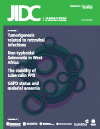Tumorigenesis related to retroviral infections
DOI:
https://doi.org/10.3855/jidc.1773Keywords:
cancer, retroviruses, retrovirus oncogenesis, transmission, HIV, HTLVAbstract
Retroviral infections are considered important risk factors for cancer development in humans since approximately 15-20% of cancer worldwide is caused by an infectious agent. This report discusses the most established oncogenic retroviruses, including human immunodeficiency virus (HIV), human T-cell leukemia virus (HTLV-1 and -2), Rous sarcoma virus (RSV), Abelson murine leukemia virus (A-MuLV), Moloney murine leukemia virus (M-MuLV), murine mammary tumor virus (MMTV), bovine leukemia virus, (BLV), Jaagsiekte sheep retrovirus (JSRV), and Friend spleen focus-forming virus (SFFV). The role of retroviruses as inducers of carcinogenesis, the mechanisms underlying oncogenic transformation, and the routes of transmission of several cancer-related retroviral infections are also described. Finally, the impact of cancer-related retroviral infections in the developing world is addressed. This review is an update of carcinogenesis caused by retroviral infections.
Downloads
Published
How to Cite
Issue
Section
License
Authors who publish with this journal agree to the following terms:
- Authors retain copyright and grant the journal right of first publication with the work simultaneously licensed under a Creative Commons Attribution License that allows others to share the work with an acknowledgement of the work's authorship and initial publication in this journal.
- Authors are able to enter into separate, additional contractual arrangements for the non-exclusive distribution of the journal's published version of the work (e.g., post it to an institutional repository or publish it in a book), with an acknowledgement of its initial publication in this journal.
- Authors are permitted and encouraged to post their work online (e.g., in institutional repositories or on their website) prior to and during the submission process, as it can lead to productive exchanges, as well as earlier and greater citation of published work (See The Effect of Open Access).








